Whaler’s Delight
Writer Leslie Gilbert Elman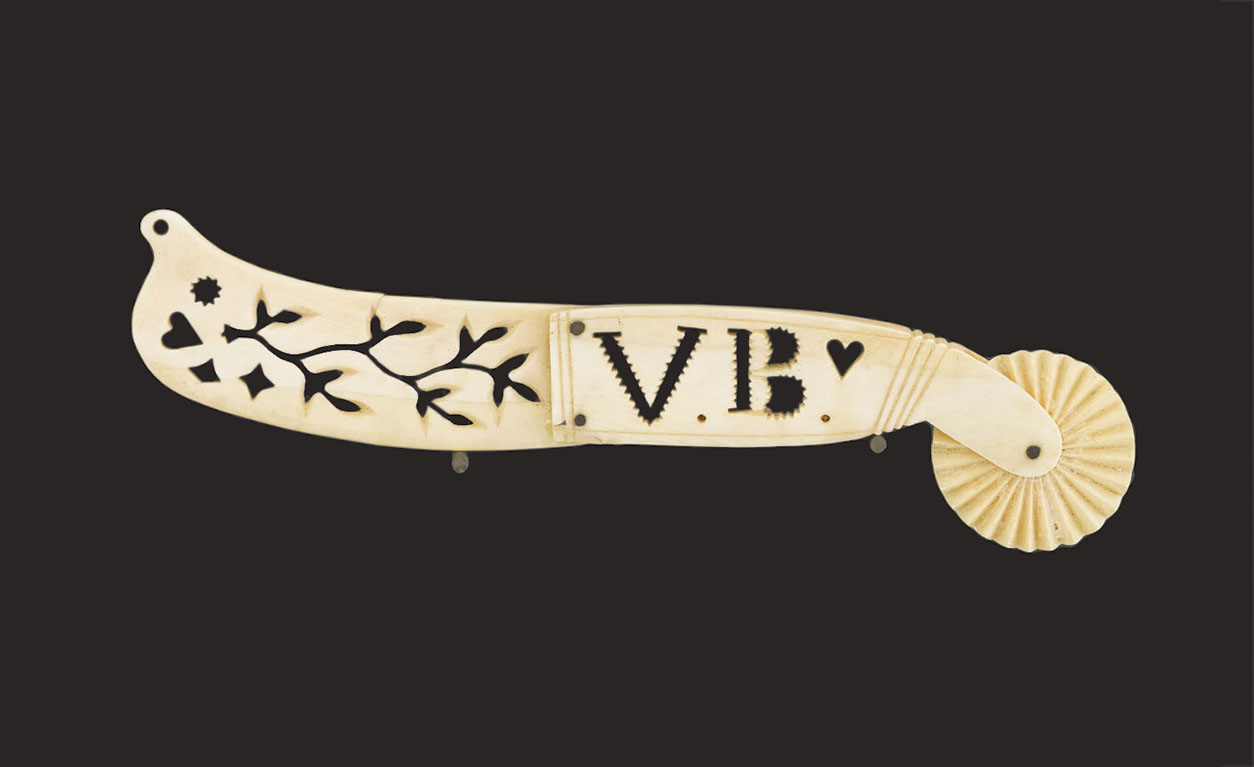
Carved from the tooth of a whale, this fluted jagging wheel was a token of love, bearing the initials V.B. and a small cut-out heart. Nantucket Historical Association Collection, gift of Mrs. W.S. Miller, catalog no. 1991.378.1.
Back in the days of Moby-Dick, men on whaling ships spent their downtime carving objects from whale bone and dreaming of pie. What other explanation could there be for the number of scrimshaw jagging wheels produced in the 19th century? Hundreds have survived to this day in museums and private collections. Each is an individual expression of craft and ingenuity made with care by whalers far from home.
Jagging wheels, also known as pie crimpers, were used to cut a neat, fluted edge on a pie crust before it was baked. Today’s bakers use them, too, although probably not often, which begs the question: Just how much pie did people eat in the 19th century? Quite a lot, as it turns out.
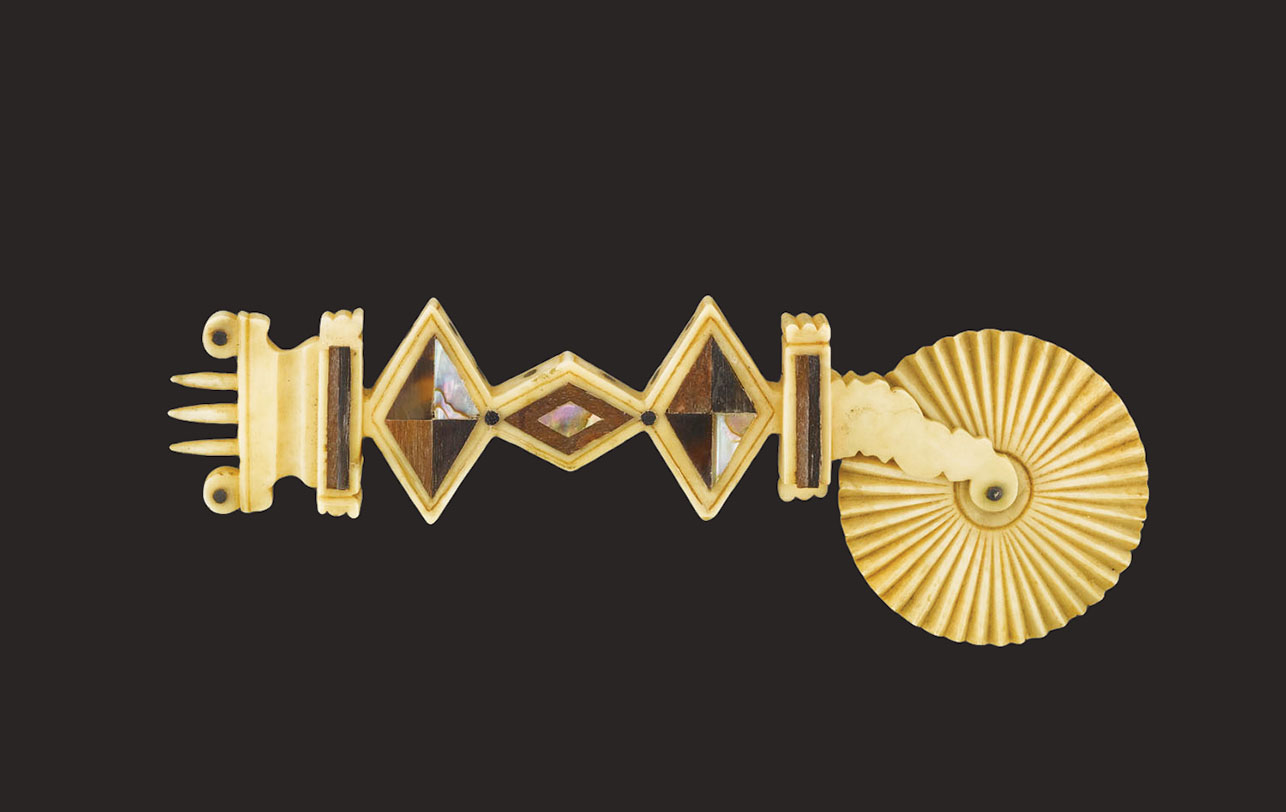
Probably made in 1840, this jagging wheel is elaborately carved and inlaid with wood, mother of pearl, abalone and tortoiseshell. Nantucket Historical Association Collection, gift of Frederick H. Gardner, catalog no. 1991.26.13.
“In New England culinary tradition there were tons of pies,” says Michael Harrison, the Obed Macy Director of Research and Collections at the Nantucket Historical Association in Massachusetts. “There were fruit pies, and there was a strong British tradition of meat and savory pies.” Stuffed with everything from eel to veal, pies also were an efficient way for thrifty New England homemakers to repackage leftovers. As a cookbook of the 1820s said, “There are few articles of cookery more generally liked than relishing-pies.”
Cooks aboard whaling ships might have baked pies as well, but they were never as tasty as the pies back home.
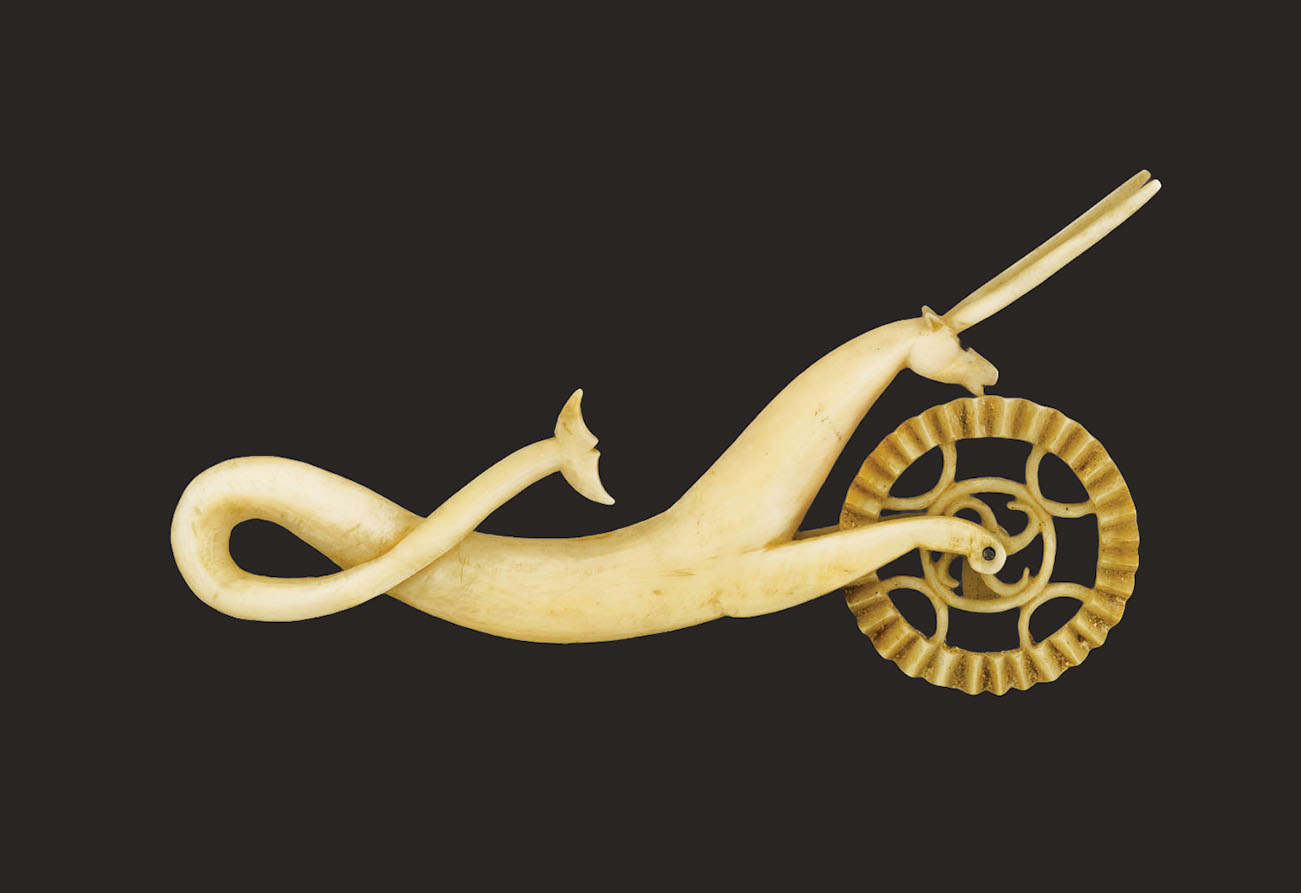
On a whaling ship in 1850, a sailor carved this fanciful sea monster jagging wheel from the tooth of a sperm whale. Nantucket Historical Association Collection, bequest of Winthrop Williams, catalog no. 1991.101.268.
Whaling in the 19th century was backbreaking, miserable work. “Whaling ships from New England would go to the Pacific to hunt sperm whales,” Harrison says. “It took four to six months to get there. Then you’re cruising around looking for whales, sometimes sailing around in circles until the ship is full.” A voyage could last three years if whales were easily found and captured; it could last five if they were elusive. And for every moment of intense activity aboard ship, there were long periods of inactivity during which the men occupied themselves making crafts from materials at hand.
Because whale teeth and bones had no economic value, the men were free to do what they liked with them. So they carved them into decorative and useful objects or engraved them with sentimental messages and scenes. The art of carving whale bone is called scrimshaw and a person who makes it is a scrimshander. (How those words originated is anyone’s guess.)
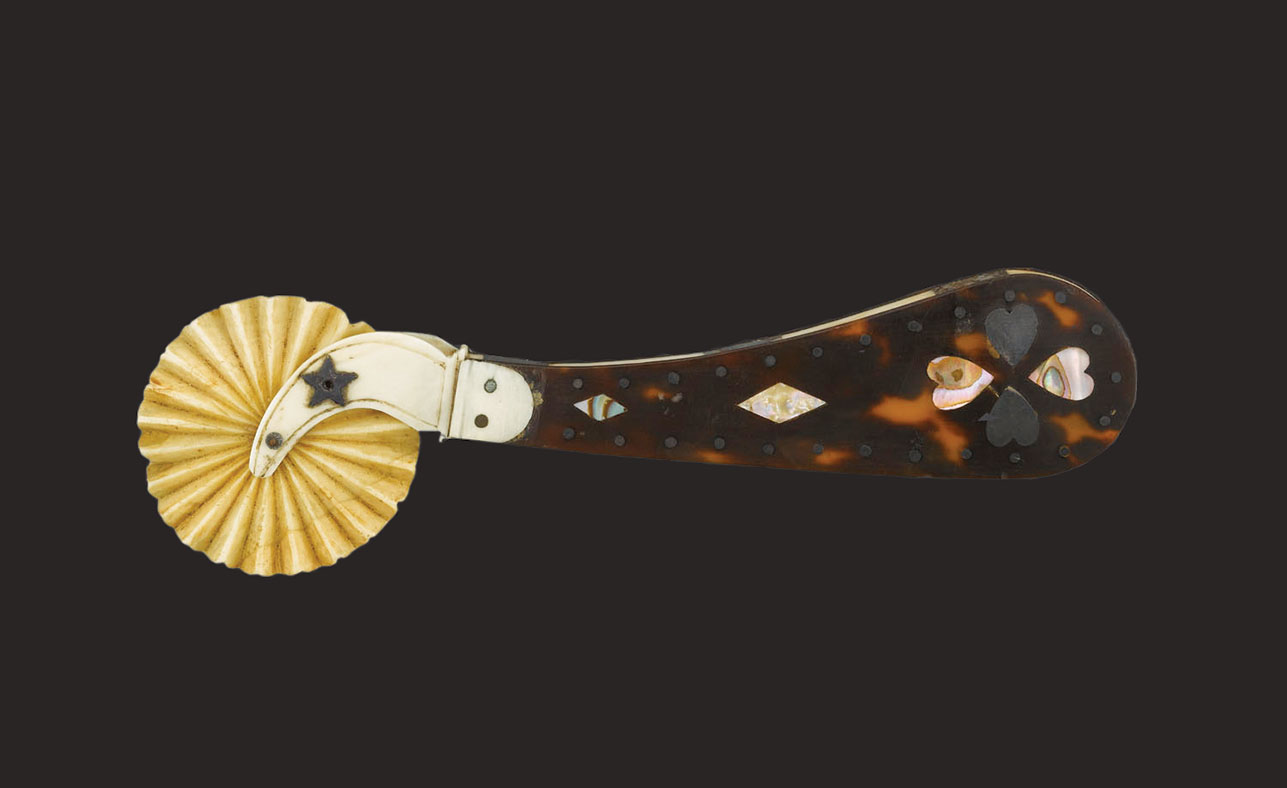
The handle of this whale ivory jagging wheel is encased in tortoiseshell that is inlaid with abalone cut in the shapes of diamonds and hearts. Nantucket Historical Association Collection, gift of Robert M. Waggaman, catalog no. 1991.196.1.
All sorts of scrimshaw trinkets were made for mothers, wives and sweethearts back home: hair combs, sewing notions, rolling pins and other kitchen gadgets as well as more personal objects such as busks used to stiffen a woman’s corset. The fact that so many jagging wheels have survived might be due to their novelty: People found them interesting, so they preserved them. Also, truth be told, many jagging wheels were too elaborate for practical use and so were kept as mementoes.
In January 2019, The Winter Show at the Park Avenue Armory in New York City featured a loan exhibition from the Nantucket Historical Association. Among the many objects related to Nantucket’s maritime history were more than two dozen scrimshaw jagging wheels. “We felt that if we exhibited one or two they might be overlooked,” Harrison says. “With so many in a group, they would be noticed.” He was right, of course.
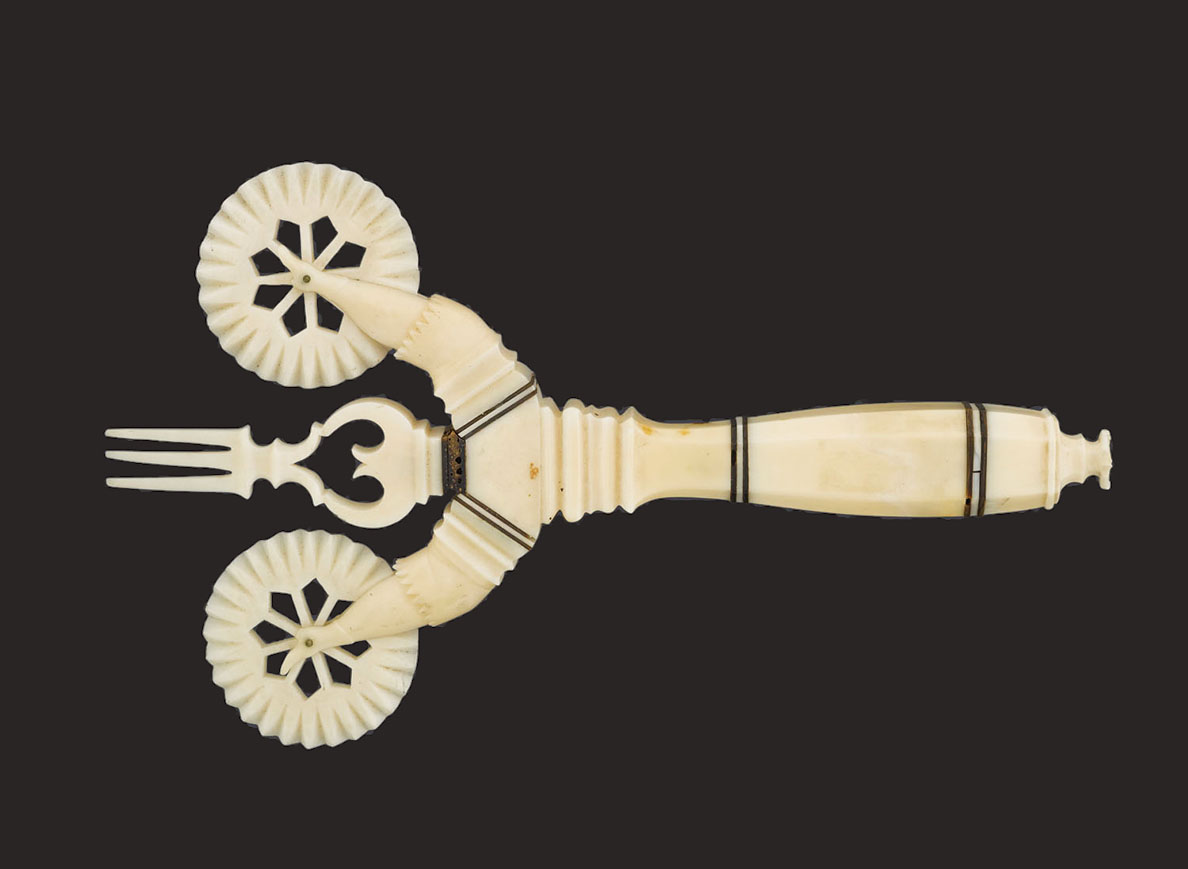
This double jagging wheel with a fork for pricking pie crust was carved from whale ivory and has accents of ebony or baleen. The wheel holders are shaped like a woman’s legs with her undergarments revealed at the top. Nantucket Historical Association Collection, donor unknown, catalog no. 1991.132.1.
Grouped together, the personality and artistry of each jagging wheel becomes apparent. They could be fanciful, refined, sometimes even bawdy, decorated with carving and inlay. While museums collect jagging wheels for their historical value — and the Nantucket Historical Association has amassed a collection of hundreds over the past 125 years — collectors look for unique pieces in pristine condition, and they will never lack for treasures to find. Eldred’s Auction Gallery in East Dennis, Massachusetts, and Rafael Osona Auctions in Nantucket are two auction houses that specialize in scrimshaw, including jagging wheels, whose auction sale prices range from hundreds to more than $10,000, depending on an object’s rarity and condition.
Such beautiful, charming objects are a true slice of history, made poignant when you consider the hands that made them. “A whaling ship was a strenuous, horrible workplace,” Harrison notes, “and this is the workplace out of which these beautiful, sentimental gifts have come.”
Leslie Gilbert Elman is the author of Weird But True: 200 Astounding, Outrageous and Totally Off the Wall Facts. She writes about antiques and other subjects for Design NJ.
The photos accompanying this article are from the book Scrimshaw on Nantucket: The Collection of the Nantucket Historical Association, by Dr. Stuart M. Frank (Nantucket Historical Association, 2019).
For more information about the Nantucket Historical Association, its Whaling Museum, and Research Library, visit NHA.org.
The 66th annual Winter Show will take place at the Park Avenue Armory in New York City from January 24 to February 2, 2020. This year’s loan exhibition will feature objects and artwork from the Hispanic Society Museum & Library. TheWinterShow.com.
